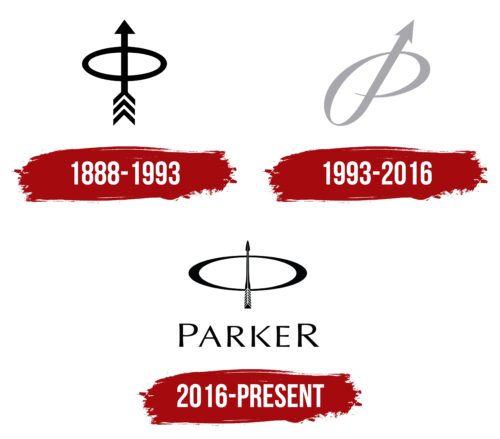The Parker logo only appears dynamic at first glance; it has a clear framework that limits movement. It’s a symbol of precision because precision is very important when it comes to writing instruments. And the style of the emblem hints that the pen can be an elite luxury item.
Parker: Brand overview
| Founded: | 1888 |
| Founder: | George Safford Parker |
| Headquarters: | Nantes, France |
| Website: | parkerpen.com |
Parker is a well-known elite brand of writing instruments that appeared in 1888 in the USA—owned by Newell Rubbermaid since 2000. It is positioned as a luxurious piece good. Fountain pens, ballpoint pens, ink, and ink cartridges are produced under the Parker logo. Pen collections include Duofold, Jotter, Premier, Sonnet, Ingenuity, and Urban. Each has copies of the basic and premium series.
While repairing broken pens at the John Holland Gold Pen Company, Sales agent George Parker came up with the Lucky Curve ink supply system. And from that moment began the 130-year history of the brand. In 1889, George patented the first pen, and in 1892 he registered the Parker Pen Company. The idea of a “perfect pen” pushed Parker to create new, more comfortable models. For 40 years (1920-60), his company remained the undisputed leader in world sales. With the spread of modern ballpoint pens, the popularity of fountain pens has declined, and now Parker pens have occupied a niche of elite goods.
Meaning and History
The company logo changed three times due to the change of owners, but the idea of a flying arrow turned out to be so successful that it is present in all variations of the emblem.
What is Parker?
Parker is an exquisite brand of writing instruments with a 130-year history. Founded in America by George Safford Parker in 1888. In the history of the company, there are about 20 successful pen models that are sold all over the world and delivered to the White House.
1888 – 1993
The first image on Parker’s pens was simple and built on associations. The sharp nib at the end of a fountain pen evoked an analogy with an arrowhead. The thin elongated shape further enhanced the similarity. Therefore, the logo depicted the company’s product in the form of an arrow flying upwards, piercing the target right in the top ten. After all, a “perfect” pen is a hit in the bull’s eye. The reversal of the composition directly into the sky demonstrated a powerful impetus for development.
The logo predicted leadership positions and the popularity of products. For the first century, Kennedy and the Queen of England signed documents with Parker’s pen, and Puccini and Conan Doyle worked with her. Even under the surrender of Germany and the agreements at the end of the Vietnam War, they signed models from Parker.
The arrow and oval design also represented the idea of suction, for which Parker’s Lucky Curve was famous. When the wearer stopped writing, the remaining ink flowed from the tip back into the reservoir, making the writing less easily soiled and free of smudges and drips. On the logo, the upward arrow symbolizes the reverse movement, and the empty oval outline symbolizes the absence of leakage.
1993 – 2016
In the nineties, Gillette set its sights on the writing instrument sector. She already owned the best-selling brand of disposable pens, Paper Mate. So in 1993, they decided to add another well-known option: a Parker pen.
The new owner has worked on the company’s style, which has not changed for the past 100 years. Thanks to Gillett, the brand logo has acquired elegance and modern design.
Now the emblem depicted a flying arrow, the trace of which wrote out the initial letter of the company’s name – a large capital R. The tip still rushed up but with a slight forward inclination. The logo symbolizes leadership, ambitions, and big claims. The shade of the emblem has also changed. The light gray color reflected stability, business qualities, and rigor.
Everything from the color to the curves of the lines spoke of impeccable style.
2016 – today
After the purchase of Newell Rubbermaid in 2000, the logo change did not happen immediately. In recent years, Parker products have not become as popular as they used to be. The office goods sector has been replaced by simpler, cheaper, and more convenient writing instruments. The new owners thought long and hard about a suitable strategy. And we decided to leave Parker pens only in the niche of luxurious, elite options. Several factories and retail outlets have been closed. And subsequently, a major rebranding was carried out, which began in 2016 and lasted two years until 2018.
To do this, we focused on the brand’s long history and colossal experience. The logo reverted back to the original first version: an arrow rushing up through an oval. But they added more sophistication and gold. Thin lines, expanding on the sides, made the oval figure refined and voluminous. The arrow’s body has acquired smooth, streamlined curves, gradually expanding downwards. All logo details seem to be forged from metal and are very durable.
In the modern image, the elements are located perpendicular to each other. The arrow vertically pierces the sky, which symbolizes a horizontally located oval. The clear upward direction of the point demonstrates the intention to reach the highest heights, the cosmos. This idea is complemented by the silhouette of an arrow, reminiscent of a rocket taking off. Not a single competitor, in this case, is equal to the company since it is impossible to rise above.
The central core of the logo resembles not only an arrow. It is also a nod to the Eiffel Tower, the symbol of France, where the brand has been headquartered in Nantes since 2011.
Below the image is a caption that complements the icon. The letters of the name are large. Their elements are of different thicknesses, which creates the impression of volume. Even lower, the company’s founding date is indicated in thin type, which emphasizes the venerable age and hints at the antique value of items from the Parker line.
Font and Colors
The main colors of the logo are black, gray, and gold. The same colors are used for product packaging.
- Initially, the sign was black. This hinted at the ink used by Parker’s pens. Gamma demonstrated market dominance and superiority over competitors.
- Light gray color – businesslike and, simultaneously, discreet and calm. He showed that the pen is an addition. The most important thing is its owner and the text that will be put on paper. Color also shifted focus away from ink as the firm’s product line expanded.
- Gold is a hint of value. The color demonstrates status, excellent quality, and the highest position in the market.
For the inscription, an elegant Optima Pro Roman font is used.
Parker color codes
| Aztec Gold | Hex color: | #b29041 |
|---|---|---|
| RGB: | 178 144 65 | |
| CMYK: | 0 19 63 30 | |
| Pantone: | PMS 1255 C |
| Black | Hex color: | #000000 |
|---|---|---|
| RGB: | 0 0 0 | |
| CMYK: | 0 0 0 100 | |
| Pantone: | PMS Process Black C |








